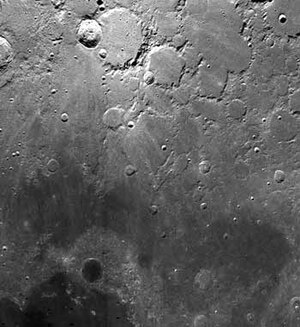Mare Frigoris
 Mare Frigoris is the dark grey material in the lower portion of this photo | |
| Coordinates | 56°00′N 1°24′E / 56.0°N 1.4°E / 56.0; 1.4Coordinates: 56°00′N 1°24′E / 56.0°N 1.4°E / 56.0; 1.4 |
|---|---|
| Diameter | 1,446 km (899 mi)[1] |
| Eponym | Sea of Cold |
Mare Frigoris (the "Sea of Cold") is a lunar mare in the far north of the Moon. It is located in the outer rings of the Procellarum basin, just north of Mare Imbrium, and stretches east to north of Mare Serenitatis. It is just north of the dark crater Plato.
Contents
1 Geology
2 History
3 Names
4 View
5 In popular culture
6 References
7 External links
Geology
The basin material surrounding the mare is of the Lower Imbrian epoch, while the eastern mare material is of the Upper Imbrian epoch, and the western mare material is of the Eratosthenian epoch.[citation needed]
History
One of the first images from a spacecraft of the sea were done by the Luna program of the 1950s and later NASA's Lunar Orbiter and Apollo missions of the 1960s and the 1970s. In December 1992, Galileo spacecraft took a picturie during its flyby of the Moon through a violet filter. It includes the surrounding features of J. Herschel, Pythagoras and a few others. It was featured in the Astronomy Picture of the Day (APOD) on July 31, 1996 titled A Violet Moon.[2]
Names
Like most of the other maria on the Moon, Mare Frigoris was named by Giovanni Riccioli, whose 1651 nomenclature system has become standardized.[3] Previously, William Gilbert had included it among the Insula Borealis ("Northern Island") in his map of c.1600,[4] and Michael Van Langren had labelled it the Mare Astronomicum ("Sea of Astronomy") in his 1645 map.[5]Pierre Gassendi called it the Boreum Mare ('Northern Sea').[6]
View

Lunar Orbiter 4 image of Mare Frigoris and vicinity. This regional view is nearly orthogonal at top but highly oblique at bottom, and north is up and slightly to the right. Mare Frigoris is the dark band extending from upper left to lower right. Mare Imbrium and Sinus Iridum are in lower left. Prominent craters include Plato with dark flat floor in bottom center, Harpalus near left edge within the mare, Philolaus at top center, and Aristoteles in lower right within the mare.
In popular culture
This area of the Moon featured prominently in 'Behemoth', the second episode of the 1973 BBC science fiction mini-series Moonbase 3.[citation needed]

Mare Frigoris on a map of the lunar nearside with major maria and craters labelled.
References
^ "Moon Mare/Maria". Gazetteer of Planetary Nomenclature. USGS Astrogeology. Retrieved 2010-08-20..mw-parser-output cite.citation{font-style:inherit}.mw-parser-output q{quotes:"""""""'""'"}.mw-parser-output code.cs1-code{color:inherit;background:inherit;border:inherit;padding:inherit}.mw-parser-output .cs1-lock-free a{background:url("//upload.wikimedia.org/wikipedia/commons/thumb/6/65/Lock-green.svg/9px-Lock-green.svg.png")no-repeat;background-position:right .1em center}.mw-parser-output .cs1-lock-limited a,.mw-parser-output .cs1-lock-registration a{background:url("//upload.wikimedia.org/wikipedia/commons/thumb/d/d6/Lock-gray-alt-2.svg/9px-Lock-gray-alt-2.svg.png")no-repeat;background-position:right .1em center}.mw-parser-output .cs1-lock-subscription a{background:url("//upload.wikimedia.org/wikipedia/commons/thumb/a/aa/Lock-red-alt-2.svg/9px-Lock-red-alt-2.svg.png")no-repeat;background-position:right .1em center}.mw-parser-output .cs1-subscription,.mw-parser-output .cs1-registration{color:#555}.mw-parser-output .cs1-subscription span,.mw-parser-output .cs1-registration span{border-bottom:1px dotted;cursor:help}.mw-parser-output .cs1-hidden-error{display:none;font-size:100%}.mw-parser-output .cs1-visible-error{font-size:100%}.mw-parser-output .cs1-subscription,.mw-parser-output .cs1-registration,.mw-parser-output .cs1-format{font-size:95%}.mw-parser-output .cs1-kern-left,.mw-parser-output .cs1-kern-wl-left{padding-left:0.2em}.mw-parser-output .cs1-kern-right,.mw-parser-output .cs1-kern-wl-right{padding-right:0.2em}
^ "A Violet Moon". Astronomy Picture of the Day (APOD). July 31, 1996. Retrieved August 22, 2017.
^ Ewen A. Whitaker, Mapping and Naming the Moon (Cambridge University Press, 1999), p.61.
^ Ewen A. Whitaker, Mapping and Naming the Moon (Cambridge University Press, 1999), p.15
^ Ewen A. Whitaker, Mapping and Naming the Moon (Cambridge University Press, 1999), p.41, 198.
^ Ewen A. Whitaker, Mapping and Naming the Moon (Cambridge University Press, 1999), p. 33.
External links
 Media related to Mare Frigoris at Wikimedia Commons
Media related to Mare Frigoris at Wikimedia Commons
"A Violet Moon". Astronomy Picture of the Day (APOD). July 31, 1996. Retrieved August 22, 2017.
Tectonics in Mare Frigoris - Lunar Reconnaissance Orbiter page and images
